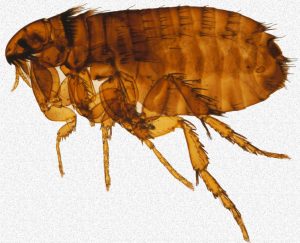aka Bartonella henselae, Bartonellosis
Ron Hines DVM PhD

Cat scratch fever is a bacterial infection of felines and people caused by a small, fragile bacteria, Bartonella henselae. There are other related bartonella that occasionally cause this disease in cats as well. Most people catch this disease after being scratched or bitten by an infected cat or being bitten by a flea that fed on an infected cat. Bartonella will occasionally affect dogs as well as cats. The bacteria is not particularly choosy as to the species of animal it infects although the symptoms and length of illness vary greatly between animal species.
What Signs Might I See If My Cat Has This Disease?
Bartonella infections are thought to be quite common in domestic cats. Veterinarians estimate that forty percent of all cats contract bartonellosis sometime in their lives. Those that venture outside unsupervised or live in a flea-rich environment or once did are at the highest risk. Many of those cats remain asymptomatic carriers of the organism for long periods of time. But the bacteria can still be cultivated from their blood or they remain PCR and/or ELISA test positive for the organism. (read here & here)
For many years, veterinarians believed that bartonella did not cause disease signs in cats. The thought was that this organism and cats had learned to live together in harmony. But several cat illnesses have now been linked to underlying bartonella infections. These include unexplained fevers, deep eye inflammation, enlargement of lymph nodes, generalized muscle pain, inflammations of the heart lining and poor reproductive success. Some cats with bartonellosis run fevers for two or three days after they first catch bartonella. This and other signs are generally quite mild and are not likely to be noticed by cat owners. However if your infected cat is later under stress for one reason or another it might only be then apparent that it has an underlying illness. Stress makes the signs of many infections worse. It might be a minor surgical procedure, an escaped cat that later found, the introduction of another cat or cattery boarding that makes the diseases apparent. It has been reported that a few cats that contract bartonellosis show mild loss of sensation in their paws, lack of balance and disorientation that resolves within a few days. Your cat’s lymph nodes might swell and some cats become moderately anemic for a few weeks after infection or relapse. At the microscopic level there is evidence that the bartonella organisms have the ability to attack the liver, kidney, spleen and the lining of the heart. However damage to those organs is usually temporary and without symptoms that you would be likely to notice.
Mouth Infections Associated With Bartonella
Veterinarians occasionally see cats with bad breath and severe mouth infections. This condition is sometimes called plasma cell stomatitis or plasmacytic stomatitis. There are some hints that bartonella might be one of the underlying causes of this disease. When these cats with oral lesions test positive for bartonella, they usually test positive for the cat immunodeficiency virus as well. These cats often show improvement when they are given azithromycin antibiotic. However, azithromycin kills many oral bacteria, so it is not really proof that bartonella was the underlying cause of the cat’s mouth problem.
Eye Problems
A high percentage of cats with inflammations of the eye are also positive for bartonella. These conditions include, uveitis, conjunctivitis, chorioretinitis, keratitis and corneal ulcers. These cats also often seem to get better when they are given azithromycin, doxycycline antibiotic, or rifampin. Azithromycin is probably the best choice because that medication also kills another organism that is sometimes involved in these eye conditions (mycoplasma). When giving these medications (particularly doxycycline) in a solid pill or capsule form to cats, be sure to follow it by giving the pet a liberal dose of oral water so that the medication does not lodge in your cat’s throat where it can damage the esophagus.
What Are The Signs That I Might Have Caught Cat Scratch Fever From My Cat?
Most people who contract this disease, caught it from a bite or a scratch from a kitten or cat under six month of age or a stray cat. But older cats can pass this infection on to humans too. The disease occurs throughout the World. The majority of cats that spread this disease to people do not look ill. Adult, indoor pet in a stable, long-term home environment are less likely to be carriers of bartonella. Eighty to ninety percent of the people who catch this disease are young adults, 2 – 24 years of age, or veterinarians. More cases occur in the fall and winter months. People who have been scratched or bitten by a bartonella-carrier cat often first develop one or more pustules (pimples) at the site of the wound. A few weeks later, their lymph nodes closest to the wound often become swollen and tender. By then the wound may have completely healed and the person may have completely forgotten about the bite or scratch. These are usually the lymph nodes at the armpit, since most bites and scratches occur on the arms or hands. Mysteriously, patients with no known exposure to cats will occasionally develop the disease. Fever, headache and fatigue are common signs of this infection when humans contract it. Some people also develop tonsillitis and neck pain. It is rare for more serious signs to develop in healthy people. Most people overcome the infection and recover over the next three weeks without treatment and never realizing what they had. However, when a person’s health is not good or the immune system that protects the person’s body is compromised, a series of much more serious symptoms can occur. The symptoms of this atypical bartonellosis are highly variable but can even be fatal. Often these are people who have undergone organ transplants, chemotherapy or are positive for immunodeficiency virus.
How Did My Cat Catch Bartonella?
We are not sure that in every case an infected cat obtained its bartonella infection from a flea. But most authorities believe that fleas are a major spreader of this disease. In the laboratory, cat fleas will transmit the disease from one cat to another. A blood transfusion from an infected cat to a non-infected cat can also spread bartonellosis. When an infected cat has fleas and scratches itself, it gets infected flea dirt (excrement) under its claws. If it then scratches a person or another cat, it can pass on the disease as well. Cat bites can also transfer bartonella between cats and from a cat to a human.
Cats in the warmer and more humid portions of the United States have the highest incidence of Bartonellosis. Prevalence is said to range from 30-50% of all cats, sometime in their lives, in warm states and from 5-7% in cats in colder states. The high-prevalence areas – warm temperatures, high humidity and high rain fall – are the same areas where cat fleas prosper.
Bartonella is thought to be able to live in infected cats for at least two years. Some authorities think that fleas can spread the disease to people but others do not. We do know that dried “flea dirt” which is the remnant of digested blood, can contain living bartonella for over nine days. We think that this dirt becomes lodged under the cat’s claws from where it is passed to people through a scratch. There are some who also suspect that ticks can transfer the disease to humans as well.
Can My Dog Catch This Disease?
I mentioned previously that that is possible. Traditionally, veterinarians thought that most dogs that were diagnosed with bartonellosis had a different species of bartonella than B. henselae, the one cats generally have. But now it appears that none of the bartonella are very choosy about which species of animal they infect.
How Will My Veterinarian Diagnose This Disease?
In Pets:
There are 5 tests that can detect if your cat has bartonella. They are the ELISA, IFA, Western Blot and PCR tests as well as an attempt to grow the bartonella organisms in the laboratory from a sample of your cat’s blood. However these tests are not always accurate. Some cats just don’t produce enough antibodies against bartonella for the first three tests to be positive. And laboratories are not always successful in growing the organism from the blood of cats that we know are infected. So repeated tests or two or more different testing methods might be necessary. The most accurate diagnosis is a positive PCR test. That test recognizes small fragments of the bartonella organism – even when they are present in extremely small amounts in the initial sample.
In People:
Diagnosis bartonellosis in people is not straight forward or easy either. Most physicians rely on a history of exposure to a cat, typical enlarged painful lymph nodes, fever and the lack of another likely cause in their patient. Other diseases such as tuberculosis, lymphoma and brucellosis will need to be ruled out. Skin tests and blood tests for humans are available.
Cat fleas as well as cat scratches and bites have the potential to transmit bartonella organisms to humans. Fleas have a short lifespan – about 12 days. (read here) So after two weeks those infected fleas should not be around to present a danger. However, the eggs those fleas laid during their lifetime can also carry bartonella. (read here) The pupa that those flea eggs develop into probably still harbor those bartonella organisms in them. It can take those cocooned flea larva many month to emerge as adult fleas that might still have the potential to spread bartonella.
How Are Bartonella Positive Cats Treated?
Although ninety percent of these cats will get better without treatment with antibiotics or other medications, your cat may take several months to fully eliminate bartonella organisms from its body. Currently, the most reliable medicine we know of is azithromycin antibiotic. It eliminates bartonella in about eighty percent of the cats after about 3 weeks of administration. Doxycycline, erythromycin, ciprofloxacin, trimethoprim/sulfa, clarithromycin and rifampin antibiotics are also effective in some cases. Some treated cats are still subject to relapse and some might becoming carrier cats that are entirely free of symptoms (asymptomatic) but still harbor the organism.
How Can I Keep My Cat and I From Catching Bartonella?
Keep your cat indoors. When you take your cat out – take it on a leash or keep it closely supervised. Indoor cats and supervised cats are much less likely to be exposed to fleas, cat bites and Bartonella. Do not take your cat to places that other cats and/or dogs frequent. Neuter or spay your cat so it does not have the urge to roam, fight and stress out. Use one of the newer flea-control products on your cat. Not all of these products are safe to use on cats. (read here)
In People:
Do not let your children roughhouse with kittens – especially kittens that were recently obtained from an animal shelter, found as strays or sold in pet shops or online give-aways. If you or your children are scratched or bitten, vigorously and immediately rinse superficial wound out with warm running water and hydrogen peroxide, isopropyl alcohol or organic iodine (Povidine®, Betadine®). Yes, I know they all sting. Deep bites need to go to your physician or the ER. If you have sores or scratches on your hands or an aggressive cat, wear gloves when handling the cat. Keep your cat’s toenails clipped short and filed smooth. Although it is not one hundred percent effective, high risk people such as those with transplants, implanted prosthetic joints, valves, etc. or immunosupressive disease and those in fragile health should, at the least, have claw guards placed on their cat’s nails or the nails blunted and filed smooth by a professional.
You are on the Vetspace animal health website
Visiting the products that you see displayed on this website help pay the cost of keeping these articles on the Internet.


